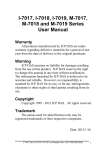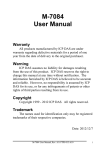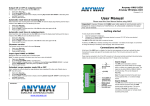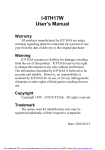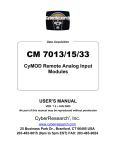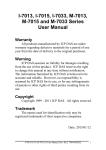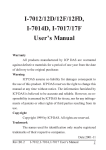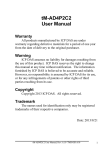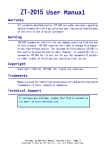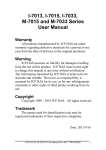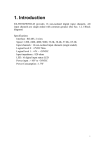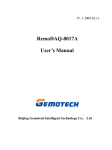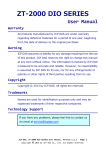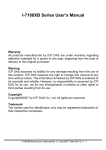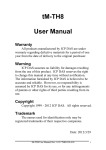Download tM-AD Series User Manual 111108
Transcript
tM-AD Series User Manual Warranty All products manufactured by ICP DAS are under warranty regarding defective materials for a period of one year from the date of delivery to the original purchaser. Warning ICP DAS assumes no liability for damages resulting from the use of this product. ICP DAS reserves the right to change this manual at any time without notification. The information furnished by ICP DAS is believed to be accurate and reliable. However, no responsibility is assumed by ICP DAS for its use, or for any infringements of patents or other rights of third parties resulting from its use. Copyright Copyright 2011 ICP DAS. All rights reserved. Trademark The names used for identification only may be registered trademarks of their respective companies. Date: 2011/12/21 tM-AD Series User Manual, Rev: A1.0 7MH-020-A10 1 Table of Contents 1. Introduction .......................................................................................................... 4 1.1 More Information ........................................................................................ 6 1.2 Terminal Assignment .................................................................................. 7 1.3 Specifications ............................................................................................ 11 1.4 Block Diagrams......................................................................................... 13 1.4.1 Block diagram for the tMAD5 ........................................................ 13 1.4.2 Block diagram for the tM-AD5C .................................................... 13 1.4.3 Block diagram for the tM-AD8....................................................... 14 1.4.4 Block diagram for the tM-AD8C .................................................... 14 1.5 Dimensions................................................................................................ 15 1.6 Wiring Diagrams ....................................................................................... 16 1.6.1 Wiring diagram for the tM-AD5 ..................................................... 16 1.6.2 Wiring diagram for the tM-AD5C .................................................. 16 1.6.3 Wiring diagram for the tM-AD8 ..................................................... 17 1.6.4 Wiring diagram for the tM-AD8C .................................................. 17 1.6.5 Wiring Recommendations............................................................... 17 1.7 Quick Start................................................................................................. 18 1.8 Default Settings ......................................................................................... 19 1.9 Calibration ................................................................................................. 20 1.10 Configuration Tables............................................................................... 21 1.11 Mounting ................................................................................................. 26 1.11.1 DIN Rail Mounting ....................................................................... 26 1.12 Technical Support.................................................................................... 28 2. DCON Protocol .................................................................................................. 29 2.1 %AANNTTCCFF ..................................................................................... 32 2.2 #AA ........................................................................................................... 35 2.3 #AAN ........................................................................................................ 37 2.4 $AA0 ......................................................................................................... 39 2.5 $AA1 ......................................................................................................... 41 2.6 $AA0Ci...................................................................................................... 43 2.7 $AA2 ......................................................................................................... 45 2.8 $AA5VV ................................................................................................... 47 2.9 $AA6 ......................................................................................................... 49 2.10 $AAA ...................................................................................................... 51 2.11 $AAF ....................................................................................................... 53 2.12 $AAM...................................................................................................... 54 2.13 $AAP ....................................................................................................... 56 2.14 $AAPN .................................................................................................... 58 2.15 ~AAEV.................................................................................................... 60 2.16 ~AAO(Name) .......................................................................................... 62 2 tM-AD Series User Manual, Rev: A1.0 7MH-020-A10 2.17 ~**........................................................................................................... 64 2.18 ~AA0 ....................................................................................................... 65 2.19 ~AA1 ....................................................................................................... 67 2.20 ~AA2 ....................................................................................................... 69 2.21 ~AA3EVV............................................................................................... 71 2.22 ~AARD.................................................................................................... 73 2.23 ~AARDVV.............................................................................................. 75 3. Modbus Protocol ................................................................................................ 77 3.1 02 (0x02) Read Input Status...................................................................... 78 3.2 04 (0x04) Read Input Channels................................................................. 79 3.3 70 (0x46) Read/Write Module Settings .................................................... 80 3.3.1 Sub-function 00 (0x00) Read module name ................................... 81 3.3.2 Sub-function 04 (0x04) Set module address ................................... 82 3.3.3 Sub-function 05 (0x05) Read communication settings................... 83 3.3.4 Sub-function 06 (0x06) Set communication settings ...................... 84 3.3.5 Sub-function 07 (0x07) Read type code.......................................... 86 3.3.6 Sub-function 08 (0x08) Set type code............................................. 87 3.3.7 Sub-function 32 (0x20) Read firmware version.............................. 88 3.3.8 Sub-function 37 (0x25) Read channel enabled/disabled status ...... 89 3.3.9 Sub-function 38 (0x26) Set channel enable/disable........................ 90 3.3.10 Sub-function 41 (0x29) Read miscellaneous settings ................... 91 3.3.11 Sub-function 42 (0x2A) Write miscellaneous settings ................. 92 3.4 Address Mappings..................................................................................... 93 3.4.1 tM-AD5 Series Address Mappings ................................................. 93 3.4.2 tM-AD5C Address Mappings ......................................................... 95 3.4.3 tM-AD8 Address Mappings ............................................................ 97 3.4.4 tM-AD8C Address Mappings ......................................................... 99 3.5 Engineering Data Format Table .............................................................. 101 4. Troubleshooting ............................................................................................... 102 4.1 Communicating with the module ............................................................ 103 4.2 Reading Data ........................................................................................... 104 A. Appendix ......................................................................................................... 105 A.1 INIT Mode.............................................................................................. 105 A.2 Dual Watchdog Operation...................................................................... 107 A.3 Frame Ground......................................................................................... 108 tM-AD Series User Manual, Rev: A1.0 7MH-020-A10 3 1. Introduction The tM series is a family of network data acquisition and control modules, providing analog-to-digital, digital-to-analog, digital input/output, timer/counter and other functions. The modules can be remotely controlled using a set of commands, which we call the DCON protocol, or the standard Modbus protocol. Communication between the module and the host is in ASCII format via an RS-485 bi-directional serial bus standard. Baud Rates are software programmable and transmission speeds of up to 115.2K baud can be selected. The tM series feature a new design for the frame ground and INIT switch as shown in the figure. The frame ground provides enhanced static protection (ESD) abilities and ensures the module is more reliable. The INIT switch allows easier access to INIT mode. Please refer to Sections A.1 and A.3 for more details. The common features of the tM-AD series are as follows: 1. 2500V DC inter-module isolation 2. 16-bit sigma-delta ADC to provide excellent accuracy 3. Software calibration 4 tM-AD Series User Manual, Rev: A1.0 7MH-020-A10 The tM-AD5 is a 5-channel differential voltage input module. The tM-AD5C is a 5-channel differential current input module. The tM-AD8 is an 8-channel single-ended voltage input module. The tM-AD8C is an 8-channel single-ended current input module. The tM-AD series are designed for industrial plant environments and have special input circuits to provide 120VDC continuous overload protection. tM-AD Series User Manual, Rev: A1.0 7MH-020-A10 5 1.1 More Information 6 For details of INIT mode operation, please refer to Section A.1 INIT Mode. For details of module watchdog and host watchdog, please refer to Section A.2 Dual Watchdog Operation. For details of ESD protection and grounding, please refer to Section A.3 Frame Ground. tM-AD Series User Manual, Rev: A1.0 7MH-020-A10 1.2 Terminal Assignment tM-AD Series User Manual, Rev: A1.0 7MH-020-A10 7 8 tM-AD Series User Manual, Rev: A1.0 7MH-020-A10 tM-AD Series User Manual, Rev: A1.0 7MH-020-A10 9 10 tM-AD Series User Manual, Rev: A1.0 7MH-020-A10 1.3 Specifications tM-AD5 tM-AD5C Analog Input Input Channels Input Type 5 differential 5 differential +/-1 V, +/-2.5 V, +/-5 V, 0~20 mA, 4~20 mA, +/-10 V +/-20 mA Resolution 14 bits (normal) 14 bits (normal) 12 bits (fast) 12 bits (fast) Sampling Rate 10 samples/sec (normal) 10 samples/sec (normal) 200 samples/sec (fast) 200 samples/sec (fast) Accuracy ±0.1% (normal) ±0.1% (normal) ±0.5% (fast) ±0.5% (fast) Zero Drift 20µV/°C 20µV/°C Span Drift 25ppm/°C 25ppm/°C Input Impedance 20MΩ 125Ω Voltage overload Protection ±120VDC Isolation 2500V DC 2500V DC Modbus RTU/ASCII Yes Yes EMS Protection ESD (IEC 61000-4-2) ±4 kV Contact for Each ±4 kV Contact for Each Terminal Terminal ±8 kV Air for Random ±8 kV Air for Random Point Point EFT (IEC 61000-4-4) ±4 kV for Power ±4 kV for Power Surge (IEC 61000-4-5) ±3 kV for Power ±3 kV for Power Power Requirement +10 to +30V DC +10 to +30V DC Consumption 1.0W 1.0W Temperature Range Operating -25°C to +75°C -25°C to +75°C Storage -30°C to +75°C -30°C to +75°C Note: A warm up period of 30 minutes is recommended in order to achieve the complete performance results described in the specifications. tM-AD Series User Manual, Rev: A1.0 7MH-020-A10 11 tM-AD8 tM-AD8C Analog Input Input Channels Input Type 8 single-ended 8 single-ended 0~500 mV, 0~1 V, 0~20 mA, 4~20 mA 0~2.5 V, 0~5 V, 0~10 V Resolution 14 bits (normal) 14 bits (normal) 12 bits (fast) 12 bits (fast) Sampling Rate 10 samples/sec (normal) 10 samples/sec (normal) 200 samples/sec (fast) 200 samples/sec (fast) Accuracy ±0.1% (normal) ±0.1% (normal) ±0.5% (fast) ±0.5% (fast) Zero Drift 20µV/°C 20µV/°C Span Drift 25ppm/°C 25ppm/°C Input Impedance 10MΩ 125Ω Voltage overload Protection ±120VDC Isolation 2500V DC 2500V DC Modbus RTU/ASCII Yes Yes EMS Protection ESD (IEC 61000-4-2) ±4 kV Contact for Each ±4 kV Contact for Each Terminal Terminal ±8 kV Air for Random ±8 kV Air for Random Point Point EFT (IEC 61000-4-4) ±2 kV for Power ±2 kV for Power Surge (IEC 61000-4-5) ±3 kV for Power ±3 kV for Power Power Requirement +10 to +30V DC +10 to +30V DC Consumption 0.6W 0.6W Temperature Range Operating -25°C to +75°C -25°C to +75°C Storage -30°C to +75°C -30°C to +75°C Note: A warm up period of 30 minutes is recommended in order to achieve the complete performance results described in the specifications. 12 tM-AD Series User Manual, Rev: A1.0 7MH-020-A10 1.4 Block Diagrams 1.4.1 Block diagram for the tMAD5 1.4.2 Block diagram for the tM-AD5C tM-AD Series User Manual, Rev: A1.0 7MH-020-A10 13 1.4.3 Block diagram for the tM-AD8 1.4.4 Block diagram for the tM-AD8C 14 tM-AD Series User Manual, Rev: A1.0 7MH-020-A10 1.5 Dimensions tM-AD Series User Manual, Rev: A1.0 7MH-020-A10 15 1.6 Wiring Diagrams 1.6.1 Wiring diagram for the tM-AD5 1.6.2 Wiring diagram for the tM-AD5C 16 tM-AD Series User Manual, Rev: A1.0 7MH-020-A10 1.6.3 Wiring diagram for the tM-AD8 1.6.4 Wiring diagram for the tM-AD8C 1.6.5 Wiring Recommendations Use 26-12 AWG wire for signal connections. Strip the wire to a length of 7±0.5mm. Use a crimp terminal for wiring. Avoid high-voltage cables and power equipment as much as possible. For RS-485 communication, use insulated and twisted pair 24 AWG wire, e.g. Belden 9841. tM-AD Series User Manual, Rev: A1.0 7MH-020-A10 17 1.7 Quick Start Please refer to the Quick Start Guide for tM series AIO. 18 tM-AD Series User Manual, Rev: A1.0 7MH-020-A10 1.8 Default Settings Default settings for the tM AD modules are as follows: 。 Protocol: Modbus RTU 。 Module Address: 01 。 Analog Input Type: type code 08, -10V to 10V 。 Baud Rate: 9600 bps tM-AD Series User Manual, Rev: A1.0 7MH-020-A10 19 1.9 Calibration Warning: It is not recommended that calibration be performed until the process is fully understood. The calibration procedure is as follows: 1. Warm up the module for 30 minutes. 2. Set the type code to the type you want to calibrate. Refer to Sections 2.1 for details. 3. Enable calibration. Refer to Section 2.15 for details. 4. Apply the zero calibration voltage/current. 5. Send the zero calibration command. Refer to Sections 2.5 for details. 6. Apply the span calibration voltage/current. 7. Send the span calibration command. Refer to Sections 2.4 and 2.6 for details. 8. Repeat steps 3 to 7 three times. Notes: 1. Connect the calibration voltage/current to channel 0. 2. Calibration voltages and currents are shown below. 3. The modules must be switched to the DCON protocol mode before calibrating. Refer to Section 3.3.4 and 3.4 for details of the switching protocol. Calibration voltages/current used by the tM-AD series: Type Code Zero Input Span Input 20 05 08 09 0A 0B 0D 0V 0V 0V 0V 0mV 0mA +2.5V +10V +5V +1V +500mV +20mA tM-AD Series User Manual, Rev: A1.0 7MH-020-A10 1.10 Configuration Tables Baud Rate Setting (CC) 7 6 Data Key Baud Data 5 4 3 2 1 0 Baud Description Baud Rate 03: 1200 04: 2400 05: 4800 06: 9600 07: 19200 08: 38400 09: 57600 0A: 115200 Data Format 0: eight data bits, no parity, and one stop bit 1: eight data bits, no parity, and two stop bit 2: eight data bits, even parity, and one stop bit 3: eight data bits, odd parity, and one stop bit tM-AD Series User Manual, Rev: A1.0 7MH-020-A10 21 Analog Input Type Setting (TT) Type Code 05 06 07 08 09 0A 0B 0D 1A Analog Input Type +/-2.5V +/-20mA +4 to +20mA +/-10V +/-5V +/-1V +/-500mV +/-20mA 0 to +20mA Range -2.5V ~ 2.5V -20mA ~ 20mA 4mA ~ 20mA -10V ~ 10V -5V ~ 5V -1V ~ 1V -500mV ~ 500mV -20mA ~ 20mA 0 ~ 20mA Notes: 1. Types 05, 08, 09 and 0A are only used in tM-AD5 and tM-AD8. 2. Types 06, 07, 0D and 1A are only used in tM-AD5C and tM-AD8C. 3. Type 0B is only used in tM-AD8 22 tM-AD Series User Manual, Rev: A1.0 7MH-020-A10 Data Format Setting (FF) 7 RS Key DF MS CS RS 6 CS 5 MS 4 3 RS 2 1 0 DF Description Data format 00: Engineering unit 01: % of FSR (full scale range) 10: 2’s complement hexadecimal Mode setting 0: Normal mode (14 bits) 1: Fast mode (12 bits) Checksum setting 0: Disabled 1: Enabled Reserved. Note: The reserved bits should be zero. tM-AD Series User Manual, Rev: A1.0 7MH-020-A10 23 Analog Input Type and Data Format Table Type code Data Format +F.S Engineering unit +2.5000 -2.5 to +2.5 *1 05 % of FSR +100.00 V 2’s comp HEX 7FFF Engineering unit +20.000 -20 to +20 *3 06 % of FSR +100.00 mA 2’s comp HEX 7FFF Engineering unit +20.000 +4 to +20 *3 07 % of FSR +100.00 mA 2’s comp HEX FFFF Engineering unit +10.000 -10 to +10 *1 08 % of FSR +100.00 V 2’s comp HEX 7FFF Engineering unit +5.0000 -5 to +5 *1 09 % of FSR +100.00 V 2’s comp HEX 7FFF Engineering unit +1.0000 -1 to +1 *1 0A % of FSR +100.00 V 2’s comp HEX 7FFF Engineering unit +500.00 -500 to +500 *2 0B % of FSR +100.00 mV 2’s comp HEX 7FFF Engineering unit +20.000 -20 to +20 *3 0D % of FSR +100.00 mA 2’s comp HEX 7FFF Engineering unit +20.000 0 to +20 *3 1A % of FSR +100.00 mA 2’s comp HEX FFFF *1: only available with the tM-AD5 and tM-AD8 *2: only available with the tM-AD8 *3: only available with the tM-AD5C and tM-AD8C. 24 Input Type tM-AD Series User Manual, Rev: A1.0 7MH-020-A10 -F.S. -2.5000 -100.00 8000 -20.000 -100.00 8000 +04.000 +000.00 0000 -10.000 -100.00 8000 -5.0000 -100.00 8000 -1.0000 -100.00 8000 -500.00 -100.00 8000 -20.000 -100.00 8000 +00.000 +000.00 0000 4 ~ 20 mA and 0 ~ 20 mA under range reading with DCON protocol Engineering Unit % of FSR 2’s Complement HEX Under Range -9999.9 -999.99 8000 4 ~ 20 mA and 0 ~ 20 mA under range reading with Modbus protocol Under Range 8000h tM-AD Series User Manual, Rev: A1.0 7MH-020-A10 25 1.11 Mounting 1.11.1 DIN Rail Mounting There are three new DIN rail models available. Each are made of stainless steel, which is stronger than those made of aluminum. There is a screw at one end and a ring terminal is included so that it can be easily connected to the earth ground. The three new DIN rail models are as follows. 26 Part number DRS-360 Max number of modules 5 Dimensions 360mm x 35mm Part number Max number of modules Dimensions tM-AD Series User Manual, Rev: A1.0 7MH-020-A10 DRS-240 3 240mm x 35mm Part number DRS-125 Max number of modules 2 Dimensions 125mm x 35mm Note: The recommended wire to connect to the earth ground is 16 – 14 AWG wire. tM-AD Series User Manual, Rev: A1.0 7MH-020-A10 27 1.12 Technical Support Should you encounter problems while using the tM series module, and are unable to find the help you need in this manual or on our website, please contact ICP DAS Product Support. Email: [email protected] Website: http://www.icpdas.com/service/support.htm When requesting technical support, be prepared to provide the following information about your system: 1. Module name and serial number: The serial number can be found printed on the barcode label attached to the cover of the module. 2. Firmware version: See Section 2.11, 3.3.7, and 3.4 for information regarding the command used to identify the firmware version. 3. Host configuration (type and operating system) 4. If the problem is reproducible, please give full details describing the procedure used to reproduce the problem. 5. Specific error messages displayed. If a dialog box with an error message is displayed, please include the full text of the dialog box, including the text in the title bar. 6. If the problem involves other programs or hardware devices, please describe the details of the problem in full. 7. Any comments and suggestions related to the problem are welcome. ICP DAS will reply to your request by email within three business days. 28 tM-AD Series User Manual, Rev: A1.0 7MH-020-A10 2. DCON Protocol All communication with tM modules consists of commands generated by the host and responses transmitted by the tM modules. Each module has a unique ID number that is used for addressing purposes and is stored in non-volatile memory. The ID is 01 by default and can be changed using a user command. All commands to the modules contain the ID address, meaning that only the addressed module will respond. The only exception to this is command ~** (Section 2.17), which is sent to all modules, but in these cases, the modules do not reply to the command. Command Format: Leading Character Module Command [CHKSUM] CR Address Response Format: Leading Character CHKSUM CR Module Address Data [CHKSUM] CR A 2-character checksum that is present when the checksum setting is enabled. See Section 1.10 and 2.1 for details. End of command character, carriage return (0x0D) tM-AD Series User Manual, Rev: A1.0 7MH-020-A10 29 Checksum Calculation: 1. Calculate the ASCII code sum of all the characters in the command/response string except for the carriage return character (CR). 2. The checksum is equal to the sum masked by 0ffh. Example: Command string: $012(CR) 1. Sum of the string = “$”+”0”+”1”+”2” = 24h+30h+31h+32h = B7h 2. Therefore the checksum is B7h, and so CHKSUM = “B7” 3. The command string with the checksum = $012B7(CR) Response string: !01200600(CR) 1. Sum of the string = “!”+”0”+”1”+”2”+”0”+”0”+”6”+”0”+”0” = 21h+30h+31h+32h+30h+30h+36h+30h+30h = 1AAh 2. Therefore the checksum is AAh, and so CHKSUM = “AA” 3. The response string with the checksum = !01200600AA(CR) Note: All characters should be in upper case. 30 tM-AD Series User Manual, Rev: A1.0 7MH-020-A10 Command General Command Sets Response Description %AANNTTCCFF !AA #AA >(Data) #AAN >(Data) $AA0 Section 2.1 !AA Set Module Configuration Reads the Analog Inputs of All Channels Reads the Analog Input of the Specified Channel Performs a Span Calibration $AA1 !AA Performs a Zero Calibration 2.5 $AA0Ci !AA Performs a Single Channel Span calibration 2.6 $AA2 !AANNTTCCFF Reads the Module Configuration 2.7 $AA5VV !AA 2.8 $AA6 !AAVV $AAA >(data) $AAF !AA(Data) Reads the Firmware Version 2.11 $AAM !AA(Data) Reads the Module Name 2.12 $AAP !AASC Reads the Protocol 2.13 $AAPN !AA Sets the Protocol 2.14 ~AAEV !AA Enables/Disables the Calibration 2.15 ~AAO(Name) !AA Sets the Module Name 2.16 Command ~** ~AA0 ~AA1 ~AA2 ~AA3ETT Enables/Disables the Channel Reads the Channel Enable/Disable Status Reads the Analog Inputs of All Channels in Hex Format Host Watchdog Command Sets Response Description No Response Host OK !AASS Reads the Host Watchdog Status !AA Resets the Host Watchdog Status Reads the Host Watchdog !AAETT Timeout Settings Sets the Host Watchdog Timeout !AA Settings tM-AD Series User Manual, Rev: A1.0 7MH-020-A10 2.2 2.3 2.4 2.9 2.10 Section 2.17 2.18 2.19 2.20 2.21 31 tM-AD5, tM-AD5C, tM-AD8, tM-AD8C 2.1 %AANNTTCCFF Description: Sets the configuration of an analog input module. Syntax: %AANNTTCCFF[CHKSUM](CR) % Delimiter character AA Address of the module to be configured in hexadecimal format (00 to FF) NN New address of the module in hexadecimal format (00 to FF) TT New type code, see Section 1.10 for details. CC New Baud Rate code, see Section 1.10 for details. To change the Baud Rate, the right slide switch must be set to the INIT position. See Section A.1 for details. FF Used to set the data format, checksum, and mode settings (Section 1.10). To change the checksum setting, the right slide switch must be set to the INIT position. See Section A.1 for details. 32 tM-AD Series User Manual, Rev: A1.0 7MH-020-A10 tM-AD5, tM-AD5C, tM-AD8, tM-AD8C Response: Valid Response: !AA[CHKSUM](CR) Invalid Response: ?AA[CHKSUM](CR) ! Delimiter character for a valid response ? Delimiter character for an invalid response. If changing the Baud Rate or checksum settings without switching the right slide switch to the INIT position, the module will return an invalid command. AA Address of the module in hexadecimal format (00 to FF) There will be no response if the command syntax is incorrect, there is a communication error, or there is no module with the specified address. tM-AD Series User Manual, Rev: A1.0 7MH-020-A10 33 tM-AD5, tM-AD5C, tM-AD8, tM-AD8C Examples: Command: %0102000600 Response: !02 Change the address of module 01 to 02. The module returns a valid response. Command: %0202000602 Response: !02 Set the data format of module 02 to be 2 (2’s complement hexadecimal). The module returns a valid response. Command: %0101000A00 Response: ?01 Change the Baud Rate of module 01 to 115200bps. The module returns an invalid command, because it is not in INIT* mode. Command: %0101000A00 Response: !01 Change the Baud Rate of module 01 to 115200bps and the module is in INIT* mode. The module returns a valid response. Related Commands: Section 2.7 $AA2 Related Topics: Section 1.10 Configuration Tables, Section A.1 INIT Mode Notes: 1. Changes to the address, type code, data format and mode settings take effect immediately after a valid command is received. Changes to the Baud Rate and checksum settings take effect on the next power on reset. 34 tM-AD Series User Manual, Rev: A1.0 7MH-020-A10 tM-AD5, tM-AD5C, tM-AD8, tM-AD8C 2.2 #AA Description: Reads the data from every analog input channel. Syntax: #AA[CHKSUM](CR) # Delimiter character AA Address of the module to be read (00 to FF) Response: Valid Response: >(Data)[CHKSUM](CR) Invalid Response: ?AA[CHKSUM](CR) > Delimiter character for a valid response ? Delimiter character for an invalid response (Data) Data from every analog input channels, see Section 1.10 for the details of data format There will be no response if the command syntax is incorrect, there is a communication error, or there is no module with the specified address. tM-AD Series User Manual, Rev: A1.0 7MH-020-A10 35 tM-AD5, tM-AD5C, tM-AD8, tM-AD8C Examples: Command: #01 Response: >+025.12+020.45+012.78+018.97+003.24+015.35+008.07+01 4.79 Reads module 01 and receives the data in engineering format. Command: #02 Response: >4C532628E2D683A20F2ADBA16284BA71 Reads module 02 and receives the data in hexadecimal format. Command: #03 Response: >-9999.9-9999.9-9999.9-9999.9-9999.9-9999.9-9999.9-9999.9 Reads module 03 and the data are under range. Related Commands: Section 2.1 %AANNTTCCFF, Section 2.7 $AA2 Related Topics: Section 1.10 Configuration Tables 36 tM-AD Series User Manual, Rev: A1.0 7MH-020-A10 tM-AD5, tM-AD5C, tM-AD8, tM-AD8C 2.3 #AAN Description: Reads the analog input of channel N. Syntax: #AAN[CHKSUM](CR) # Delimiter character AA Address of the module to be read (00 to FF) N The channel to be read, zero based. Response: Valid Response: >(Data)[CHKSUM](CR) Invalid Response: ?AA[CHKSUM](CR) > Delimiter character for a valid response ? Delimiter character for an invalid response. An invalid command is returned if the specified channel is incorrect. (Data) Analog input data of the specified channel, see Section 1.10 for details of the data format. AA Address of the responding module (00 to FF) There will be no response if the command syntax is incorrect, there is a communication error, or there is no module with the specified address. tM-AD Series User Manual, Rev: A1.0 7MH-020-A10 37 tM-AD5, tM-AD5C, tM-AD8, tM-AD8C Examples: Command: #032 Response: >+025.13 Reads data from channel 2 of module 03. Command: #0511 Response: >+025.13 Reads data from channel 17 of module 05 for an I-7017Z in single-ended mode. Command: #029 Response: ?02 Reads data from channel 9 of module 02. An error is returned because channel 9 is invalid. Related Commands: Section 2.1 %AANNTTCCFF, Section 2.7 $AA2 Related Topics: Section 1.10 Configuration Tables 38 tM-AD Series User Manual, Rev: A1.0 7MH-020-A10 tM-AD5, tM-AD8 2.4 $AA0 Description: Performs a span calibration. Syntax: $AA0[CHKSUM](CR) $ Delimiter character AA Address of the module to be calibrated (00 to FF) 0 Command for the span calibration Response: Valid Response: !AA[CHKSUM](CR) Invalid Response: ?AA[CHKSUM](CR) ! Delimiter character for a valid response ? Delimiter character for an invalid response AA Address of the responding module (00 to FF) There will be no response if the command syntax is incorrect, there is a communication error, or there is no module with the specified address. tM-AD Series User Manual, Rev: A1.0 7MH-020-A10 39 tM-AD5, tM-AD8 Examples: Command: $010 Response: !01 Performs a span calibration on module 01 and returns a valid response. Command: $020 Response: ?02 Performs a span calibration on module 02. An invalid command is returned because the “enable calibration” command was not sent in advance. Related Commands: Section 2.5 $AA1, Section 2.15 ~AAEV Related Topics: Section 1.9 Calibration Notes: 1. This command is only applicable to tM-AD5 and tM-AD8. 2. The “enable calibration” command, ~AAEV, must be sent before this command is used, see Section 1.9 for details. 40 tM-AD Series User Manual, Rev: A1.0 7MH-020-A10 tM-AD5, tM-AD5C, tM-AD8, tM-AD8C 2.5 $AA1 Description: Performs a zero calibration. Syntax: $AA1[CHKSUM](CR) $ Delimiter character AA Address of the module to be set (00 to FF) 1 Command for the zero calibration Response: Valid Response: !AA[CHKSUM](CR) Invalid Response: ?AA[CHKSUM](CR) ! Delimiter character for a valid response ? Delimiter character for an invalid response AA Address of the responding module (00 to FF) There will be no response if the command syntax is incorrect, there is a communication error, or there is no module with the specified address. tM-AD Series User Manual, Rev: A1.0 7MH-020-A10 41 tM-AD5, tM-AD5C, tM-AD8, tM-AD8C Examples: Command: $011 Response: !01 Performs a zero calibration on module 01 and returns a valid response. Command: $021 Response: ?02 Performs a zero calibration on module 02. An invalid command is returned because the “enable calibration” command was not sent in advance. Related Commands: Section 2.4 $AA0, Section 2.15 ~AAEV Related Topics: Section 1.9 Calibration Note: The “enable calibration” command, ~AAEV, must be sent before this command is used, see Section 1.9 for details. 42 tM-AD Series User Manual, Rev: A1.0 7MH-020-A10 tM-AD5C, tM-AD8C 2.6 $AA0Ci Description: Performs a span calibration on the specified channel. Syntax: $AA1Ci[CHKSUM](CR) $ Delimiter character AA Address of the module to be calibrated (00 to FF) 1 Command for the span calibration Ci Specifies the channel to be calibrated Response: Valid Response: !AA[CHKSUM](CR) Invalid Response: ?AA[CHKSUM](CR) ! Delimiter character for a valid response ? Delimiter character for an invalid response. An invalid command is returned if the specified channel is incorrect. AA Address of the responding module (00 to FF) There will be no response if the command syntax is incorrect, there is a communication error, or there is no module with the specified address. tM-AD Series User Manual, Rev: A1.0 7MH-020-A10 43 tM-AD5C, tM-AD8C Examples: Command: $011C0 Response: !01 Performs a span calibration on channel 0 of module 01 and returns a valid response. Command: $021C5 Response: !02 Performs a span calibration on channel 5 of module 02 and returns a valid response. Command: $031C1 Response: ?03 Performs a span calibration on channel 1 of module 03. An invalid command is returned because the “enable calibration” command was not sent in advance. Related Commands: Section 2.5 $AA1, Section 2.15 ~AAEV Related Topics: Section 1.9 Calibration Notes: 1. This command is only applicable to tM-AD5 and tM-AD8. 2. The “enable calibration” command, ~AAEV, must be sent before this command is used, see Section 1.9 for details. 44 tM-AD Series User Manual, Rev: A1.0 7MH-020-A10 tM-AD5, tM-AD5C, tM-AD8, tM-AD8C 2.7 $AA2 Description: Reads the module configuration. Syntax: $AA2[CHKSUM](CR) $ Delimiter character AA Address of the module to be read (00 to FF) 2 Command to read the module configuration Response: Valid Response: !AATTCCFF[CHKSUM](CR) Invalid Response: ?AA[CHKSUM](CR) ! Delimiter character for a valid response ? Delimiter character for an invalid response AA Address of the responding module (00 to FF) TT Type code of the module, see Section 1.10 for details. CC Baud Rate code of the module, see Section 1.10 for details. FF Data format, checksum settings and mode settings of the module, see Section 1.10 for details. There will be no response if the command syntax is incorrect, there is a communication error, or there is no module with the specified address. tM-AD Series User Manual, Rev: A1.0 7MH-020-A10 45 tM-AD5, tM-AD5C, tM-AD8, tM-AD8C Examples: Command: $012 Response: !01050600 Reads the configuration of module 01. Command: $022 Response: !02030602 Reads the configuration of module 02. Related Commands: Section 2.1 %AANNTTCCFF Related Topics: Section 1.10 Configuration Tables, Section A.1 INIT Mode 46 tM-AD Series User Manual, Rev: A1.0 7MH-020-A10 tM-AD5, tM-AD5C, tM-AD8, tM-AD8C 2.8 $AA5VV Description: Specifies the channel(s) to be enabled. Syntax: $AA5VV(VV)[CHKSUM](CR) $ Delimiter character AA Address of the module to be set (00 to FF) 5 Command to set the channel(s) to enabled VV A two-digit hexadecimal value, where bit 0 corresponds to channel 0, bit 1 corresponds to channel 1, etc. When the bit is 1 it means that the channel is enabled and 0 means that the channel is disabled. Response: Valid Response: !AA[CHKSUM](CR) Invalid Response: ?AA[CHKSUM](CR) ! Delimiter character for a valid response ? Delimiter character for an invalid response. An invalid command is returned if an attempt is made to enable a channel that is not present. AA Address of the responding module (00 to FF) tM-AD Series User Manual, Rev: A1.0 7MH-020-A10 47 tM-AD5, tM-AD5C, tM-AD8, tM-AD8C There will be no response if the command syntax is incorrect, there is a communication error, or there is no module with the specified address. Examples: Command: $0153A Response: !01 Enables channels 1, 3, 4, and 5 and disables all other channels of module 01. The module returns a valid response. Command: $016 Response: !013A Reads the channel status of module 01 and returns a response of 3A, meaning that channels 1, 3, 4, and 5 are enabled and all other channels are disabled. Related Commands: Section 2.9 $AA6 Note: 1. It is recommended that only the channels that will be used are enabled. 48 tM-AD Series User Manual, Rev: A1.0 7MH-020-A10 tM-AD5, tM-AD5C, tM-AD8, tM-AD8C 2.9 $AA6 Description: Reads the enabled/disabled status of each channel. Syntax: $AA6[CHKSUM](CR) $ Delimiter character AA Address of the module to be read (00 to FF) 6 Command to read the channel status Response: Valid Response: !AAVV(VV)[CHKSUM](CR) Invalid Response: ?AA[CHKSUM](CR) ! Delimiter character for a valid response ? Delimiter character for an invalid response AA Address of the responding module (00 to FF) VV A two-digit hexadecimal value, where bit 0 corresponds to channel 0, bit 1 corresponds to channel 1, etc. When the bit is 1 it means that the channel is enabled and 0 means that the channel is disabled. There will be no response if the command syntax is incorrect, there is a communication error, or there is no module with the specified address. tM-AD Series User Manual, Rev: A1.0 7MH-020-A10 49 tM-AD5, tM-AD5C, tM-AD8, tM-AD8C Examples: Command: $0153A Response: !01 Enables channels 1, 3, 4, and 5 and disables all other channels of module 01. The module returns a valid response. Command: $016 Response: !013A Reads the channel status of module 01 and returns a response of 3A, meaning that channels 1, 3, 4, and 5 are enabled and all other channels are disabled. Related Commands: Section 2.8 $AA5VV 50 tM-AD Series User Manual, Rev: A1.0 7MH-020-A10 tM-AD5, tM-AD5C, tM-AD8, tM-AD8C 2.10 $AAA Description: Reads the data from every analog input channel in hex format. Syntax: $AAA[CHKSUM](CR) $ Delimiter character AA Address of the module to be read (00 to FF) A Command to read every analog input Response: Valid Response: >(Data)[CHKSUM](CR) Invalid Response: ?AA[CHKSUM](CR) > Delimiter character for a valid response ? Delimiter character for an invalid response (Data) Data from every analog input channels in hex format. There will be no response if the command syntax is incorrect, there is a communication error, or there is no module with the specified address. tM-AD Series User Manual, Rev: A1.0 7MH-020-A10 51 tM-AD5, tM-AD5C, tM-AD8, tM-AD8C Examples: Command: $01A Response: >0000012301257FFF1802744F98238124 Reads module 01 and receives the data in hex format. Related Commands: Section 2.2 #AA 52 tM-AD Series User Manual, Rev: A1.0 7MH-020-A10 tM-AD5, tM-AD5C, tM-AD8, tM-AD8C 2.11 $AAF Description: Reads the firmware version of a module. Syntax: $AAF[CHKSUM](CR) $ Delimiter character AA Address of the module to be read (00 to FF) F Command to read the firmware version Response: Valid Response: !AA(Data)[CHKSUM](CR) Invalid Response: ?AA[CHKSUM](CR) ! Delimiter character for a valid response ? Delimiter character for an invalid response AA Address of the responding module (00 to FF) (Data) A string indicating the firmware version of the module There will be no response if the command syntax is incorrect, there is a communication error, or there is no module with the specified address. Examples: Command: $01F Response: !01A2.0 Reads the firmware version of module 01, and shows that it is version A2.0. tM-AD Series User Manual, Rev: A1.0 7MH-020-A10 53 tM-AD5, tM-AD5C, tM-AD8, tM-AD8C 2.12 $AAM Description: Reads the name of a module. Syntax: $AAM[CHKSUM](CR) $ Delimiter character AA Address of the module to be read (00 to FF) M Command to read the module name Response: Valid Response: !AA(Name)[CHKSUM](CR) Invalid Response: ?AA[CHKSUM](CR) ! Delimiter character for a valid response ? Delimiter character for an invalid response AA Address of the responding module (00 to FF) (Name) A string showing the name of the module There will be no response if the command syntax is incorrect, there is a communication error, or there is no module with the specified address. 54 tM-AD Series User Manual, Rev: A1.0 7MH-020-A10 tM-AD5, tM-AD5C, tM-AD8, tM-AD8C Examples: Command: $01M Response: !017018 Reads the module name of module 01 and returns the name “7018”. Related Commands: Section 2.16 ~AAO(Name) tM-AD Series User Manual, Rev: A1.0 7MH-020-A10 55 tM-AD5, tM-AD5C, tM-AD8, tM-AD8C 2.13 $AAP Description: Reads the communication protocol information. Syntax: $AAP[CHKSUM](CR) $ Delimiter character AA Address of the module to be read (00 to FF) P Command to read the communication protocol Response: Valid Response: !AASC[CHKSUM](CR) Invalid Response: ?AA[CHKSUM](CR) ! Delimiter character for a valid response ? Delimiter character for an invalid response AA Address of the responding module (00 to FF) S The protocols supported by the module 0: only DCON protocol is supported 1: both the DCON and Modbus RTU protocols are supported 3: all of the DCON and Modbus RTU/ASCII protocols are supported C Current protocol saved in EEPROM that will be used at the next power on reset 0: the protocol set in EEPROM is DCON 1: the protocol set in EEPROM is Modbus RTU 3: the protocol set in the EEPROM is Modbus ASCII 56 tM-AD Series User Manual, Rev: A1.0 7MH-020-A10 tM-AD5, tM-AD5C, tM-AD8, tM-AD8C There will be no response if the command syntax is incorrect, there is a communication error, or there is no module with the specified address. Examples: Command: $01P Response: !0110 Reads the communication protocol of module 01 and returns a response of 10 meaning that it supports both the DCON and Modbus RTU protocols and the protocol that will be used at the next power on reset is DCON. Related Commands: Section 2.14 $AAPN tM-AD Series User Manual, Rev: A1.0 7MH-020-A10 57 tM-AD5, tM-AD5C, tM-AD8, tM-AD8C 2.14 $AAPN Description: Sets the communication protocol. Syntax: $AAPN[CHKSUM](CR) $ Delimiter character AA Address of the module to be read (00 to FF) P Command to set the communication protocol N 0: DCON protocol 1: Modbus RTU protocol 3: Modbus ASCII protocol Before using this command, the right slide switch must be in the INIT position, see Section A.1 for details. The new protocol is saved in the EEPROM and will be effective after the next power on reset. Response: Valid Response: !AA[CHKSUM](CR) Invalid Response: ?AA[CHKSUM](CR) ! Delimiter character for a valid response ? Delimiter character for an invalid response AA Address of the responding module (00 to FF) There will be no response if the command syntax is incorrect, there is a communication error, or there is no module with the specified address. 58 tM-AD Series User Manual, Rev: A1.0 7MH-020-A10 tM-AD5, tM-AD5C, tM-AD8, tM-AD8C Examples: Command: $01P1 Response: ?01 Sets the communication protocol of module 01 to Modbus RTU and returns an invalid response because the module is not in INIT mode. Command: $01P1 Response: !01 Sets the communication protocol of module 01 to Modbus RTU and returns a valid response. Related Commands: Section 2.13 $AAP Related Topics: Section A.1 INIT Mode tM-AD Series User Manual, Rev: A1.0 7MH-020-A10 59 tM-AD5, tM-AD5C, tM-AD8, tM-AD8C 2.15 ~AAEV Description: Enable/Disable module calibration. Syntax: ~AAEV[CHKSUM](CR) ~ Delimiter character AA Address of the module to be set (00 to FF) E Command to enable/disable calibration V 1: enable calibration 0: disable calibration Response: Valid Response: !AA[CHKSUM](CR) Invalid Response: ?AA[CHKSUM](CR) ! Delimiter character for a valid response ? Delimiter character for an invalid response AA Address of the responding module (00 to FF) There will be no response if the command syntax is incorrect, there is a communication error, or there is no module with the specified address. 60 tM-AD Series User Manual, Rev: A1.0 7MH-020-A10 tM-AD5, tM-AD5C, tM-AD8, tM-AD8C Examples: Command: $010 Response: ?01 Sends the command to perform a span calibration on module 01. It returns an invalid response because the “enable calibration” command was not sent in advance. Command: ~01E1 Response: !01 Enables calibration on module 01 and returns a valid response. Command: $010 Response: !01 Sends the command to perform a span calibration on module 01 and returns a valid response. Related Commands: Section 2.4 $AA0, Section 2.5 $AA1, Section 2.6 $AA0Ci Related Topics: Section 1.9 Calibration tM-AD Series User Manual, Rev: A1.0 7MH-020-A10 61 tM-AD5, tM-AD5C, tM-AD8, tM-AD8C 2.16 ~AAO(Name) Description: Sets the name of a module. Syntax: ~AAO(Name)[CHKSUM](CR) ~ Delimiter character AA Address of the module to be set (00 to FF) O Command to set the module name (Name) New name of the module (max. 6 characters). Response: Valid Response: !AA[CHKSUM](CR) Invalid Response: ?AA[CHKSUM](CR) ! Delimiter character for a valid response ? Delimiter character for an invalid response AA Address of the responding module (00 to FF) There will be no response if the command syntax is incorrect, there is a communication error, or there is no module with the specified address. 62 tM-AD Series User Manual, Rev: A1.0 7MH-020-A10 tM-AD5, tM-AD5C, tM-AD8, tM-AD8C Examples: Command: ~01O7019A Response: !01 Sets the name of module 01 to be “7019A” and returns a valid response. Command: $01M Response: !017019A Reads the name of module 01 and returns “7019A”. Related Commands: Section 2.12 $AAM tM-AD Series User Manual, Rev: A1.0 7MH-020-A10 63 tM-AD5, tM-AD5C, tM-AD8, tM-AD8C 2.17 ~** Description: Informs all modules that the host is OK. Syntax: ~**[CHKSUM](CR) ~ Delimiter character ** Host OK command Response: No response. Examples: Command: ~** No response Sends a “Host OK” command to all modules. Related Commands: Section 2.18 ~AA0, Section 2.19 ~AA1, Section 2.20 ~AA2, Section 2.21 ~AA3EVV Related Topics: Section A.2 Dual Watchdog Operation Note: After sending this command, there must be a 2ms delay before the next command can be sent. 64 tM-AD Series User Manual, Rev: A1.0 7MH-020-A10 tM-AD5, tM-AD5C, tM-AD8, tM-AD8C 2.18 ~AA0 Description: Reads the host watchdog status of a module. Syntax: ~AA0[CHKSUM](CR) ~ Delimiter character AA Address of the module to be read (00 to FF) 0 Command to read the module status Response: Valid Response: !AASS[CHKSUM](CR) Invalid Response: ?AA[CHKSUM](CR) ! Delimiter character for a valid response ? Delimiter character for an invalid response AA Address of the responding module (00 to FF) SS Two hexadecimal digits that represent the host watchdog status, where: Bit 7: 0 indicates that the host watchdog is disabled and 1 indicates the host watchdog is enabled, Bit 2: 1 indicates that a host watchdog time out has occurred and 0 indicates that no host watchdog time out has occurred. The host watchdog status is stored in EEPROM and can only be reset using the ~AA1 command. tM-AD Series User Manual, Rev: A1.0 7MH-020-A10 65 tM-AD5, tM-AD5C, tM-AD8, tM-AD8C There will be no response if the command syntax is incorrect, there is a communication error, or there is no module with the specified address. Examples: Command: ~010 Response: !0100 Reads the host watchdog status of module 01 and returns 00, meaning that the host watchdog is disabled and no host watchdog time out has occurred. Command: ~020 Response: !0204 Reads the host watchdog status of module 02 and returns 04, meaning that a host watchdog timeout has occurred. Related Commands: Section 2.17 ~**, Section 2.19 ~AA1, Section 2.20 ~AA2, Section 2.21 ~AA3EVV Related Topics: Section A.2 Dual Watchdog Operation 66 tM-AD Series User Manual, Rev: A1.0 7MH-020-A10 tM-AD5, tM-AD5C, tM-AD8, tM-AD8C 2.19 ~AA1 Description: Resets the host watchdog time out status of a module. Syntax: ~AA1[CHKSUM](CR) ~ Delimiter character AA Address of the module to be set (00 to FF) 1 Command to reset the host watchdog time out status Response: Valid Response: !AA[CHKSUM](CR) Invalid Response: ?AA[CHKSUM](CR) ! Delimiter character for a valid response ? Delimiter character for an invalid response AA Address of the responding module (00 to FF) There will be no response if the command syntax is incorrect, there is a communication error, or there is no module with the specified address. tM-AD Series User Manual, Rev: A1.0 7MH-020-A10 67 tM-AD5, tM-AD5C, tM-AD8, tM-AD8C Examples: Command: ~010 Response: !0104 Reads the host watchdog status of module 01 and shows that a host watchdog time out has occurred. Command: ~011 Response: !01 Resets the host watchdog time out status of module 01 and returns a valid response. Command: ~010 Response: !0100 Reads the host watchdog status of module 01 and shows that no host watchdog time out has occurred. Related Commands: Section 2.17 ~**, Section 2.18 ~AA0, Section 2.20 ~AA2, Section 2.21 ~AA3EVV Related Topics: Section A.2 Dual Watchdog Operation 68 tM-AD Series User Manual, Rev: A1.0 7MH-020-A10 tM-AD5, tM-AD5C, tM-AD8, tM-AD8C 2.20 ~AA2 Description: Reads the host watchdog time out value of a module. Syntax: ~AA2[CHKSUM](CR) ~ Delimiter character AA Address of the module to be read (00 to FF) 2 Command to read the host watchdog time out value Response: Valid Response: !AAEVV[CHKSUM](CR) Invalid Response: ?AA[CHKSUM](CR) ! Delimiter character for a valid response ? Delimiter character for an invalid response AA Address of the responding module (00 to FF) E 1: the host watchdog is enabled 0: the host watchdog is disabled VV Two hexadecimal digits to represent the time out value in tenths of a second, for example, 01 means 0.1 seconds and FF means 25.5 seconds. There will be no response if the command syntax is incorrect, there is a communication error, or there is no module with the specified address. tM-AD Series User Manual, Rev: A1.0 7MH-020-A10 69 tM-AD5, tM-AD5C, tM-AD8, tM-AD8C Examples: Command: ~012 Response: !011FF Reads the host watchdog time out value of module 01 and returns FF, meaning that the host watchdog is enabled and the host watchdog time out value is 25.5 seconds. Related Commands: Section 2.17 ~**, Section 2.18 ~AA0, Section 2.19 ~AA1, Section 2.21 ~AA3EVV Related Topics: Section A.2 Dual Watchdog Operation 70 tM-AD Series User Manual, Rev: A1.0 7MH-020-A10 tM-AD5, tM-AD5C, tM-AD8, tM-AD8C 2.21 ~AA3EVV Description: Enables/disables the host watchdog and set the host watchdog time out value of a module. Syntax: ~AA3EVV[CHKSUM](CR) ~ Delimiter character AA Address of the module to be set (00 to FF) 3 Command to set the host watchdog E 1: enable the host watchdog 0: disable the host watchdog VV Two hexadecimal digits to represent the time out value in tenths of a second, for example, 01 means 0.1 seconds and FF means 25.5 seconds. Response: Valid Response: !AA[CHKSUM](CR) Invalid Response: ?AA[CHKSUM](CR) ! Delimiter character for a valid response ? Delimiter character for an invalid response AA Address of the responding module (00 to FF) There will be no response if the command syntax is incorrect, there is a communication error, or there is no module with the specified address. tM-AD Series User Manual, Rev: A1.0 7MH-020-A10 71 tM-AD5, tM-AD5C, tM-AD8, tM-AD8C Examples: Command: ~013164 Response: !01 Enables the host watchdog of module 01 and sets the host watchdog time out value to 10.0 seconds. The module returns a valid response. Command: ~012 Response: !01164 Reads the host watchdog time out value of module 01. The module returns 164, meaning that the host watchdog is enabled and the host watchdog time out value is 10.0 seconds. Related Commands: Section 2.17 ~**, Section 2.18 ~AA0, Section 2.19 ~AA1, Section 2.20 ~AA2 Related Topics: Section A.2 Dual Watchdog Operation 72 tM-AD Series User Manual, Rev: A1.0 7MH-020-A10 tM-AD5, tM-AD5C, tM-AD8, tM-AD8C 2.22 ~AARD Description: Reads the response delay time value of a module. Syntax: ~AARD[CHKSUM](CR) ~ Delimiter character AA Address of the module to be read (00 to FF) RD Command to read the response delay time value Response: Valid Response: !AAVV[CHKSUM](CR) Invalid Response: ?AA[CHKSUM](CR) ! Delimiter character for a valid response ? Delimiter character for an invalid response AA Address of the responding module (00 to FF) VV Two hexadecimal digits to represent the response delay time value in milli-second, for example, 01 denotes 1ms and 1E denotes 30ms. The max allowable value is 30 (1Eh). There will be no response if the command syntax is incorrect, there is a communication error, or there is no module with the specified address. tM-AD Series User Manual, Rev: A1.0 7MH-020-A10 73 tM-AD5, tM-AD5C, tM-AD8, tM-AD8C Examples: Command: ~01RD Response: !0102 Reads the response delay time value of module 01 and returns 02, which denotes that the response delay time value is 2ms. Related Commands: Section 2.23 ~AARDVV 74 tM-AD Series User Manual, Rev: A1.0 7MH-020-A10 tM-AD5, tM-AD5C, tM-AD8, tM-AD8C 2.23 ~AARDVV Description: Sets the response delay time value of a module. Syntax: ~AARDVV[CHKSUM](CR) ~ Delimiter character AA Address of the module to be read (00 to FF) RD Command to set the communication protocol VV Two hexadecimal digits to represent the response delay time value in milli-second, for example, 01 denotes 1ms and 1E denotes 30s. The max allowable value is 30 (1Eh). Response: Valid Response: !AA[CHKSUM](CR) Invalid Response: ?AA[CHKSUM](CR) ! Delimiter character for a valid response ? Delimiter character for an invalid response AA Address of the responding module (00 to FF) There will be no response if the command syntax is incorrect, there is a communication error, or there is no module with the specified address. tM-AD Series User Manual, Rev: A1.0 7MH-020-A10 75 tM-AD5, tM-AD5C, tM-AD8, tM-AD8C Examples: Command: ~01RD06 Response: !01 Sets the response delay time value to 6ms. The module returns a valid response. Command: ~01RD Response: !0106 Reads the response delay time value of module 01. The module returns 06, which denotes that the response delay time value is 6ms. Related Commands: Section 2.22 ~AARD 76 tM-AD Series User Manual, Rev: A1.0 7MH-020-A10 3. Modbus Protocol The Modbus protocol is developed by Modicon Inc., originally developed for Modicon controllers. Detailed information can be found at http://www.modicon.com/techpubs/toc7.html. You can also visit http://www.modbus.org to find more valuable information. The tM series modules support both the Modbus RTU and Modbus ASCII protocols. The communication Baud Rates range from 1200bps to 115200bps. The following Modbus functions are supported. Function Code 02 (0x02) 04 (0x04) 70 (0x46) Description Read input status Read input channels Read/write module settings Section 3.1 3.2 3.3 If the function specified in the message is not supported, then the module responds as follows. Error Response 00 01 02 Address Function code Exception code 1 Byte 1 to 247 1 Byte Function code | 0x80 1 Byte 01 If a CRC mismatch occurs, the module will not respond. tM-AD Series User Manual, Rev: A1.0 7MH-020-A10 77 tM-AD5, tM-AD5C, tM-AD8, tM-AD8C 3.1 02 (0x02) Read Input Status This function code is used to read the open wire status of a module in the current input type. Request 00 Address 01 Function code 02 ~ 03 Starting channel 1 Byte 1 to 247 1 Byte 0x02 2 Bytes 0x80 to 0x87 (0x84 for tM-AD5C), where 0x80 corresponds to channel 0, 0x81 corresponds to channel 1, etc 04 ~ 05 Number of input 2 Bytes N, 1 to 8 (5 for tM-AD5C); channels (Starting channel + N) should be less than or equal to 0x88 (0x85 for tM-AD5C) Note: This function is only available on tM-AD5C and tM-AD8C. Response 00 01 02 03 Address Function code Byte count Data of input channels 1 Byte 1 Byte 1 Byte 1 Byte 1 to 247 0x02 1 A bit corresponds to a channel. When the bit is 1 it denotes that the channel is enabled and is either over-range, under-range or wire opening. If the bit is 0 it denotes that the channel is disabled or normal. 1 Byte 1 Byte 1 Byte 1 to 247 0x82 02: starting channel out of range 03: (starting channel + number of input channels) out of range, incorrect number of bytes received Error Response 00 01 02 78 Address Function code Exception code tM-AD Series User Manual, Rev: A1.0 7MH-020-A10 tM-AD5, tM-AD5C, tM-AD8, tM-AD8C 3.2 04 (0x04) Read Input Channels This function code is used to read from contiguous analog input channels. Request 00 Address 01 Function code 02 ~ 03 Starting channel 04 ~ 05 Number of input channels (N) 1 Byte 1 to 247 1 Byte 0x04 2 Bytes 0 to 7 (4 for tM-AD5 and tM-AD5C) for reading analog inputs 2 Bytes 1 to 8 (5 for tM-AD5 and tM-AD5C); (Starting channel + N) <= 8 (5 for tM-AD5 and tM-AD5C) for reading analog inputs. Response 00 01 02 03 ~ Address Function code Byte count Data of input channels 1 Byte 1 Byte 1 Byte 2xN Bytes 1 to 247 0x04 2xN 1 Byte 1 Byte 1 Byte 1 to 247 0x84 02: starting channel out of range 03: (starting channel + number of input channels) out of range, incorrect number of bytes received Error Response 00 01 02 Address Function code Exception code tM-AD Series User Manual, Rev: A1.0 7MH-020-A10 79 3.3 70 (0x46) Read/Write Module Settings This function code is used to read the settings of the module or change the settings of the module. The following sub-function codes are supported. Sub-function Code 00 (0x00) 04 (0x04) 05 (0x05) 06 (0x06) 07 (0x07) 08 (0x08) 32 (0x20) 37 (0x25) 38 (0x26) 41 (0x29) 42 (0x2A) Description Section Read the module name 3.3.1 Set the module address 3.3.2 Read the communication settings 3.3.3 Set the communication settings 3.3.4 Read the type code 3.3.5 Set the type code 3.3.6 Read the firmware version 3.3.7 Read the channel enable/disable 3.3.8 status Set the channel enable/disable 3.3.9 Read the miscellaneous settings 3.3.10 Write the miscellaneous settings 3.3.11 If the module does not support the sub-function code specified in the message, then it responds as follows. Error Response 00 Address 01 Function code 02 Exception code 80 1 Byte 1 Byte 1 Byte 1 to 247 0xC6 02: invalid sub-function code tM-AD Series User Manual, Rev: A1.0 7MH-020-A10 tM-AD5, tM-AD5C, tM-AD8, tM-AD8C 3.3.1 Sub-function 00 (0x00) Read module name This sub-function code is used to read the name of a module. Request 00 01 02 Address 1 Byte Function code 1 Byte Sub function code 1 Byte 1 to 247 0x46 0x00 Response 00 01 02 03 ~ 06 Address Function code Sub function code Module name 1 Byte 1 Byte 1 Byte 4 Bytes 1 to 247 0x46 0x00 0x07 0x00 0x50 0x01 for tM-AD5 0x07 0x00 0x50 0x02 for tM-AD5C 0x07 0x00 0x80 0x01 for tM-AD8 0x07 0x00 0x80 0x02 for tM-AD8C 1 Byte 1 Byte 1 Byte 1 to 247 0xC6 03: incorrect number of bytes received Error Response 00 01 02 Address Function code Exception code tM-AD Series User Manual, Rev: A1.0 7MH-020-A10 81 tM-AD5, tM-AD5C, tM-AD8, tM-AD8C 3.3.2 Sub-function 04 (0x04) Set module address This sub-function code is used to set the address of a module. Request 00 01 02 03 04 ~ 06 Address Function code Sub function code New address Reserved 1 Byte 1 Byte 1 Byte 1 Byte 3 Bytes 1 to 247 0x46 0x04 1 to 247 0x00 0x00 0x00 Response 00 01 02 03 Address Function code Sub function code Set address result 04 ~ 06 Reserved 1 Byte 1 Byte 1 Byte 1 Byte 1 to 247 0x46 0x04 0: OK, others: error 3 Bytes 0x00 0x00 0x00 Error Response 00 01 02 82 Address Function code Exception code 1 Byte 1 Byte 1 Byte 1 to 247 0xC6 03: new address out of range, reserved bytes should be filled with zero, incorrect number of bytes received tM-AD Series User Manual, Rev: A1.0 7MH-020-A10 tM-AD5, tM-AD5C, tM-AD8, tM-AD8C 3.3.3 Sub-function 05 (0x05) Read communication settings This sub-function code is used to read the communication protocol settings of a module. Request 00 01 02 03 Address Function code Sub function code Reserved 1 Byte 1 Byte 1 Byte 1 Byte 1 to 247 0x46 0x05 0x00 Response 00 01 02 03 Address Function code Sub function code Protocol supported Baud Rate 1 Byte 1 Byte 1 Byte 1 Byte 1 to 247 0x46 0x05 0x00: Modbus RTU 0x03: Modbus RTU & ASCII 04 1 Byte Baud Rate code, see Section 1.10 for details. 05 Reserved 1 Bytes 0x00 06 Data format 1 Byte 0x00: no parity, 1 stop bit 0x01: no parity, 2 stop bits 0x02: even parity, 1 stop bit 0x03: odd parity, 1 stop bit 07 Reserved 1 Bytes 0x00 08 Mode 1 Byte 0x00: DCON protocol 0x01: Modubs RTU protocol 0x03: Modbus ASCII protocol 09 ~ 10 Reserved 2 Bytes 0x00 0x00 Note: This information is the data saved in the EEPROM and will be used for the next power-on reset. It is not the currently used settings. Error Response 00 01 02 Address Function code Exception code 1 Byte 1 Byte 1 Byte 1 to 247 0xC6 03: reserved byte should be filled with zero, incorrect number of bytes received tM-AD Series User Manual, Rev: A1.0 7MH-020-A10 83 tM-AD5, tM-AD5C, tM-AD8, tM-AD8C 3.3.4 Sub-function 06 (0x06) Set communication settings This sub-function code is used to set the communication protocol of a module. Request 00 01 02 03 04 Address Function code Sub function code Reserved Baud Rate 05 06 Reserved Data format 07 08 Reserved Mode 09 ~ 10 Reserved 84 1 Byte 1 Byte 1 Byte 1 Byte 1 Byte 1 to 247 0x46 0x06 0x00 Baud Rate code, see Section 1.10 for details. 1 Byte 0x00 1 Byte 0x00: no parity, 1 stop bit 0x01: no parity, 2 stop bits 0x02: even parity, 1 stop bit 0x03: odd parity, 1 stop bit 1 Byte 0x00 1 Byte 0x00: DCON protocol 0x01: Modubs RTU protocol 0x03: Modubs ASCII protocol 2 Bytes 0x00 0x00 tM-AD Series User Manual, Rev: A1.0 7MH-020-A10 tM-AD5, tM-AD5C, tM-AD8, tM-AD8C Response 00 01 02 03 04 05 06 Address Function code Sub function code Reserved Baud Rate Reserved Data format 1 Byte 1 Byte 1 Byte 1 Byte 1 Byte 1 Byte 1 Byte 1 to 247 0x46 0x06 0x00 0x00: OK, others: error 0x00 0x00 0x00 0x00: OK, others: error 07 Reserved 1 Byte 0x00 08 Mode 1 Byte 0x00: OK, others: error 09 ~ 10 Reserved 2 Bytes 0x00 0x00 Note: The new Baud Rate and protocol will be effective after the next power-on reset. Error Response 00 01 02 Address Function code Exception code 1 Byte 1 Byte 1 Byte 1 to 247 0xC6 03: Baud Rate or mode out of range, reserved bytes should be filled with zero, incorrect number of bytes received tM-AD Series User Manual, Rev: A1.0 7MH-020-A10 85 tM-AD5, tM-AD5C, tM-AD8, tM-AD8C 3.3.5 Sub-function 07 (0x07) Read type code This sub-function code is used to read the type code information of a module. Request 00 01 02 03 04 Address Function code Sub function code Reserved Reserved 1 Byte 1 Byte 1 Byte 1 Bytes 1 Byte 1 to 247 0x46 0x07 0x00 0x00 1 Byte 1 Byte 1 Byte 1 Byte 1 to 247 0x46 0x07 Type code, see Section 1.10 for details. 1 Byte 1 Byte 1 Byte 1 to 247 0xC6 03: reserved bytes should be filled with zero Response 00 01 02 03 Address Function code Sub function code Type code Error Response 00 01 02 86 Address Function code Exception code tM-AD Series User Manual, Rev: A1.0 7MH-020-A10 tM-AD5, tM-AD5C, tM-AD8, tM-AD8C 3.3.6 Sub-function 08 (0x08) Set type code This sub-function code is used to set the type code of a module. Request 00 01 02 03 04 05 Address Function code Sub function code Reserved Reserved Type code 1 Byte 1 Byte 1 Byte 1 Byte 1 Byte 1 Byte 1 to 247 0x46 0x08 0x00 0x00 Type code, see Section 1.10 for details. 1 Byte 1 Byte 1 Byte 1 Byte 1 to 247 0x46 0x08 0x00: OK others: error 1 Byte 1 Byte 1 Byte 1 to 247 0xC6 03: type code out of range, reserved bytes should be filled with zero, incorrect number of bytes received Response 00 01 02 03 Address Function code Sub function code Type code Error Response 00 01 02 Address Function code Exception code tM-AD Series User Manual, Rev: A1.0 7MH-020-A10 87 tM-AD5, tM-AD5C, tM-AD8, tM-AD8C 3.3.7 Sub-function 32 (0x20) Read firmware version This sub-function code is used to read the firmware version information of a module. Request 00 01 02 Address 1 Byte Function code 1 Byte Sub function code 1 Byte 1 to 247 0x46 0x20 Response 00 01 02 03 04 05 Address Function code Sub function code Major version Minor version Build version 1 Byte 1 Byte 1 Byte 1 Byte 1 Byte 1 Byte 1 to 247 0x46 0x20 0x00 ~ 0xFF 0x00 ~ 0xFF 0x00 ~ 0xFF 1 Byte 1 Byte 1 Byte 1 to 247 0xC6 03: incorrect number of bytes received Error Response 00 01 02 88 Address Function code Exception code tM-AD Series User Manual, Rev: A1.0 7MH-020-A10 tM-AD5, tM-AD5C, tM-AD8, tM-AD8C 3.3.8 Sub-function 37 (0x25) Read channel enabled/disabled status This sub-function code is used to read the enabled/disabled status of each channel in a module. Request 00 01 02 Address 1 Byte Function code 1 Byte Sub function code 1 Byte 1 to 247 0x46 0x25 Response 00 01 02 03 Address Function code Sub function code Enabled/disabled status 1 Byte 1 Byte 1 Byte 1 Byte 1 to 247 0x46 0x25 0x00 ~ 0xFF, enabled/disabled status of each channel, where bit 0 corresponds to channel 0, bit 1 corresponds to channel 1, etc. When the bit is 1 it denotes that the channel is enabled and 0 denotes that the channel is disabled. 0x00 ~ 0x01F for tM-AD5 and tM-AD5C 1 Byte 1 Byte 1 Byte 1 to 247 0xC6 03: incorrect number of bytes received Error Response 00 01 02 Address Function code Exception code tM-AD Series User Manual, Rev: A1.0 7MH-020-A10 89 tM-AD5, tM-AD5C, tM-AD8, tM-AD8C 3.3.9 Sub-function 38 (0x26) Set channel enable/disable This sub-function code is used to specify the channels to be enabled in a module. Request 00 01 02 03 Address Function code Sub function code Enable/disable setting 1 Byte 1 Byte 1 Byte 1 Byte 1 to 247 0x46 0x26 0x00 ~ 0xFF, enable/disable setting of each channel, where bit 0 corresponds to channel 0, bit 1 corresponds to channel 1, etc. When the bit is 1 it denotes that the channel is enabled and 0 denotes that the channel is disabled. 0x00 ~ 0x01F for tM-AD5 and tM-AD5C 1 Byte 1 Byte 1 Byte 1 Byte 1 to 247 0x46 0x26 0: OK others: error. 1 Byte 1 Byte 1 Byte 1 to 247 0xC6 03: enable/disable setting out of range, incorrect number of bytes received Response 00 01 02 03 Address Function code Sub function code Enable/disable setting Error Response 00 01 02 90 Address Function code Exception code tM-AD Series User Manual, Rev: A1.0 7MH-020-A10 tM-AD5, tM-AD5C, tM-AD8, tM-AD8C 3.3.10 Sub-function 41 (0x29) Read miscellaneous settings This sub-function code is used to read the miscellaneous settings of a module. Request 00 01 02 Address 1 Byte Function code 1 Byte Sub function code 1 Byte 1 to 247 0x46 0x29 Response 00 01 02 03 Address Function code Sub function code Miscellaneous settings 1 Byte 1 Byte 1 Byte 1 Byte 1 to 247 0x46 0x29 Bit 7~6: reserved Bit 5: mode setting 0: normal mode 1: fast mode Bit 4~0: reserved Note: The reserved fields are filled with zeros. Error Response 00 01 02 Address Function code Exception code 1 Byte 1 Byte 1 Byte 1 to 247 0xC6 03: incorrect number of bytes received tM-AD Series User Manual, Rev: A1.0 7MH-020-A10 91 tM-AD5, tM-AD5C, tM-AD8, tM-AD8C 3.3.11 Sub-function 42 (0x2A) Write miscellaneous settings This sub-function code is used to set the miscellaneous settings of a module. Request 00 01 02 03 Address Function code Sub function code Miscellaneous settings 1 Byte 1 Byte 1 Byte 1 Byte 1 to 247 0x46 0x2A Bit 7~6: reserved Bit 5: mode setting 0: normal mode 1: fast mode Bit 4~0: reserved Note: The reserved fields are filled with zeros. Response 00 01 02 03 Address Function code Sub function code Miscellaneous settings 1 Byte 1 Byte 1 Byte 1 Byte 1 to 247 0x46 0x2A 0: OK others: error 1 Byte 1 Byte 1 Byte 1 to 247 0xC6 03: reserved bits should be filled with zero, incorrect number of bytes received Error Response 00 01 02 92 Address Function code Exception code tM-AD Series User Manual, Rev: A1.0 7MH-020-A10 3.4 Address Mappings 3.4.1 tM-AD5 Series Address Mappings Address 30001 ~ 30005 40001 ~ 40005 40481 40482 40483 40484 40485 40486 Description Analog input value of channel 0 to 4 Attribute R Firmware version (low word) Firmware version (high word) Module name (low word) , 0x5001 Module name (high word) , 0x0700 Module address, valid range: 1 ~ 247 Bits 5:0 Baud rate, 0x03 ~ 0x0A R R R R R/W R/W Code Baud Code Baud 40487 40488 40489 40490 40492 0x03 1200 0x07 19200 0x04 2400 0x08 38400 0x05 4800 0x09 57600 0x06 9600 0x0A 115200 Bits 7:6 00: no parity, 1 stop bit 01: no parity, 2 stop bits 10: even parity, 1 stop bit 11: odd parity, 1 stop bit Type code R/W Modbus response delay time in ms, R/W valid range: 0 ~ 30 Host watchdog timeout value, 0 ~ 255, R/W in 0.1s Channel enable/disable, 00h ~ 1Fh R/W Host watchdog timeout count, write 0 R/W to clear tM-AD Series User Manual, Rev: A1.0 7MH-020-A10 93 Address Description Attribute 00257 Protocol, 0: DCON, 1: Modbus RTU R/W Protocol, 0: determined by 00257, 1: 00258 R/W Modbus ASCII 00261 00269 00270 00271 00273 94 1: enable, 0: disable host watchdog Modbus data format, 0: hex, 1: engineering Host watch dog timeout status, write 1 to clear host watch dog timeout status 1: enable, 0: disable fast mode Reset status, 1: first read after powered on, 0: not the first read after powered on R/W R/W R/W R/W R tM-AD Series User Manual, Rev: A1.0 7MH-020-A10 3.4.2 tM-AD5C Address Mappings Address 10129 ~ 10133 00129 ~ 00133 30001 ~ 30005 40001 ~ 40005 40481 40482 40483 40484 40485 40486 Description Attribute Over/under range status of channel 0 R to 4 for 4 ~ 20mA or 0 ~ 20mA ranges Analog input value of channel 0 to 4 R Firmware version (low word) Firmware version (high word) Module name (low word) , 0x5002 Module name (high word) , 0x0700 Module address, valid range: 1 ~ 247 Bits 5:0 Baud rate, 0x03 ~ 0x0A R R R R R/W R/W Code Baud Code Baud 40487 40488 40489 40490 40492 0x03 1200 0x07 19200 0x04 2400 0x08 38400 0x05 4800 0x09 57600 0x06 9600 0x0A 115200 Bits 7:6 00: no parity, 1 stop bit 01: no parity, 2 stop bits 10: even parity, 1 stop bit 11: odd parity, 1 stop bit Type code R/W Modbus response delay time in ms, R/W valid range: 0 ~ 30 Host watchdog timeout value, 0 ~ 255, R/W in 0.1s Channel enable/disable, 00h ~ 1Fh R/W Host watchdog timeout count, write 0 R/W to clear tM-AD Series User Manual, Rev: A1.0 7MH-020-A10 95 Address Description Attribute 00257 Protocol, 0: DCON, 1: Modbus RTU R/W Protocol, 0: determined by 00257, 1: 00258 R/W Modbus ASCII 00261 00269 00270 00271 00273 96 1: enable, 0: disable host watchdog Modbus data format, 0: hex, 1: engineering Host watch dog timeout status, write 1 to clear host watch dog timeout status 1: enable, 0: disable fast mode Reset status, 1: first read after powered on, 0: not the first read after powered on R/W R/W R/W R/W R tM-AD Series User Manual, Rev: A1.0 7MH-020-A10 3.4.3 tM-AD8 Address Mappings Address 30001 ~ 30008 40001 ~ 40008 40481 40482 40483 40484 40485 40486 Description Analog input value of channel 0 to 7 Attribute R Firmware version (low word) Firmware version (high word) Module name (low word), 0x8001 Module name (high word), 0x0700 Module address, valid range: 1 ~ 247 Bits 5:0 Baud rate, 0x03 ~ 0x0A R R R R R/W R/W Code Baud Code Baud 40487 40488 40489 40490 40492 0x03 1200 0x07 19200 0x04 2400 0x08 38400 0x05 4800 0x09 57600 0x06 9600 0x0A 115200 Bits 7:6 00: no parity, 1 stop bit 01: no parity, 2 stop bits 10: even parity, 1 stop bit 11: odd parity, 1 stop bit Type code R/W Modbus response delay time in ms, R/W valid range: 0 ~ 30 Host watchdog timeout value, 0 ~ 255, R/W in 0.1s Channel enable/disable, 00h ~ FFh R/W Host watchdog timeout count, write 0 R/W to clear tM-AD Series User Manual, Rev: A1.0 7MH-020-A10 97 Address Description Attribute 00257 Protocol, 0: DCON, 1: Modbus RTU R/W Protocol, 0: determined by 00257, 1: 00258 R/W Modbus ASCII 00261 00269 00270 00271 00273 98 1: enable, 0: disable host watchdog Modbus data format, 0: hex, 1: engineering Host watch dog timeout status, write 1 to clear host watch dog timeout status 1: enable, 0: disable fast mode Reset status, 1: first read after powered on, 0: not the first read after powered on R/W R/W R/W R/W R tM-AD Series User Manual, Rev: A1.0 7MH-020-A10 3.4.4 tM-AD8C Address Mappings Address 10129 ~ 10136 00129 ~ 00136 30001 ~ 30008 40001 ~ 40008 40481 40482 40483 40484 40485 40486 Description Attribute Over/under range status of channel 0 R to 7 for 4 ~ 20mA or 0 ~ 20mA ranges Analog input value of channel 0 to 7 R Firmware version (low word) Firmware version (high word) Module name (low word) , 0x8002 Module name (high word) , 0x0700 Module address, valid range: 1 ~ 247 Bits 5:0 Baud rate, 0x03 ~ 0x0A R R R R R/W R/W Code Baud Code Baud 40487 40488 40489 40490 40492 0x03 1200 0x07 19200 0x04 2400 0x08 38400 0x05 4800 0x09 57600 0x06 9600 0x0A 115200 Bits 7:6 00: no parity, 1 stop bit 01: no parity, 2 stop bits 10: even parity, 1 stop bit 11: odd parity, 1 stop bit Type code R/W Modbus response delay time in ms, R/W valid range: 0 ~ 30 Host watchdog timeout value, 0 ~ 255, R/W in 0.1s Channel enable/disable, 00h ~ FFh R/W Host watchdog timeout count, write 0 R/W to clear tM-AD Series User Manual, Rev: A1.0 7MH-020-A10 99 Address Description Attribute 00257 Protocol, 0: DCON, 1: Modbus RTU R/W Protocol, 0: determined by 00257, 1: 00258 R/W Modbus ASCII 00261 00269 00270 00271 00273 100 1: enable, 0: disable host watchdog Modbus data format, 0: hex, 1: engineering Host watch dog timeout status, write 1 to clear host watch dog timeout status 1: enable, 0: disable fast mode Reset status, 1: first read after powered on, 0: not the first read after powered on R/W R/W R/W R/W R tM-AD Series User Manual, Rev: A1.0 7MH-020-A10 3.5 Engineering Data Format Table Type Code 05 06 07 08 09 0A 0B 0D 1A Input Type -2.5 V ~ +2.5 V -20 mA ~ +20 mA +4 mA ~ +20 mA -10 V ~ +10 V -5 V ~ +5 V -1 V ~ +1 V -500 mV ~ +500 mV -20 mA ~ +20 mA 0 ~ +20 mA Min. -25000 -20000 4000 -10000 -5000 -10000 -5000 -20000 0 Max. 25000 20000 20000 10000 5000 10000 5000 20000 20000 The under range value is –32768 and the over range value is +32767. For the hex data format, please refer to Section 1.10. tM-AD Series User Manual, Rev: A1.0 7MH-020-A10 101 4. Troubleshooting If you are having difficulty using the tM module, here are some suggestions that may help. If you cannot find the answers you need in these guides, contact ICP DAS Product Support. Contact information is located in Section 1.12. 102 tM-AD Series User Manual, Rev: A1.0 7MH-020-A10 4.1 Communicating with the module If you attempt to communicate with the module and receive no response, first check the following: Make sure the supplied power is within the range of +10 to +30 V DC. If the supplied power is OK, then the power LED should be on. When the module receives a command, the power LED is set to “off”. The power LED is shown as “on” after the module responds. This method can be used to check whether the module has received a command sent from the host. If possible, use another device to check whether the host can communicate with the device through the same RS-485 network. If the host is a PC installed with a Windows operating system, then execute the DCON Utility to determine whether the module can be found. The DCON Utility can be downloaded from the ICP DAS website http://www.icpdas.com. The DCON Utility documentation can be found in the “Getting Started For I-7000 Series Modules” manual. Set the module to “INIT mode” and communicate with the module using the following settings: address 00, Baud Rate 9600bps, no checksum and DCON protocol. See Section A.1 for details. tM-AD Series User Manual, Rev: A1.0 7MH-020-A10 103 4.2 Reading Data If the data read from the input channel is not correct, first check the following: Make sure the type code and data format settings are correct. The type code is set by using the %AANNTTCCFF command, see Section 2.1 for details. The data format is set by using the %AANNTTCCFF command. For the Modbus RTU protocol, the type code is set by using sub-function 08h of the function 46h. If the voltage read by the module is incorrect, then it may be because the calibration parameters stored in the non-volatile memory are corrupted. You can calibrate the module by yourself. Be sure to read Section 1.9 in detail before doing any calibration. 104 tM-AD Series User Manual, Rev: A1.0 7MH-020-A10 A. Appendix A.1 INIT Mode Each tM module has a built-in EEPROM to store configuration information such as module address, type code, Baud Rate, etc. Occasionally, the configuration of a module may be forgotten and there are no visual indications of the configuration of the module. It is difficult to communicate with the module when the configuration of the module is unknown. To help avoid this problem, the tM series has a special mode called “INIT mode”. When the module is powered on in “INIT mode” the configuration of the module is reset as follows, allowing it to be operated as normal. 1. 2. 3. 4. Address: 00 Baud Rate: 9600 bps No checksum Protocol: DCON The configuration information stored in the EEPROM is not changed and they can be read by sending the $002(CR) command at 9600bps. There are commands that require the module to be in INIT mode. They are: 1. %AANNTTCCFF when changing Baud Rate and checksum settings. See Section 2.1 for details. 2. $AAPN, see Section 2.14 for details. tM-AD Series User Manual, Rev: A1.0 7MH-020-A10 105 The tM modules have the INIT switch located on the right side of the module allow easier access to INIT mode. For these modules, INIT mode is accessed by sliding the INIT switch to the Init position as shown below. 106 tM-AD Series User Manual, Rev: A1.0 7MH-020-A10 A.2 Dual Watchdog Operation Dual Watchdog = Module Watchdog + Host Watchdog The Module Watchdog is a hardware reset circuit that monitors the operating status of the module. While working in harsh or noisy environments, the module may be shut down by external signals. The circuit allows the module to work continuously without disruption. The Host Watchdog is a software function that monitors the operating status of the host. Its purpose is to prevent problems due to network/communication errors or host malfunctions. When a host watchdog time out occurs, the module will reset all outputs to a safe state in order to prevent any erroneous operations of the controlled target. The tM series modules include an internal Dual Watchdog, making the control system more reliable and stable. For more information regarding the Dual Watchdog, please refer to Chapter 5 of the “Getting Started For I-7000 Series Modules” manual that can be downloaded from the ICP DAS website http://www.icpdas.com. tM-AD Series User Manual, Rev: A1.0 7MH-020-A10 107 A.3 Frame Ground Electronic circuits are constantly vulnerable to ESD which become worse in a continental climate area. The tM modules feature a new design for the frame ground. The frame ground provides a path for bypassing ESD, which provides enhanced static protection (ESD) abilities and ensures the module is more reliable. Connect the frame ground terminal to a wire/DIN rail and connect the wire/DIN rail to the earth ground will provide a better protection for the module. 108 tM-AD Series User Manual, Rev: A1.0 7MH-020-A10












































































































